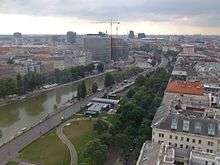Donaukanal



The Donaukanal ("Danube Canal") is a former arm of the river Danube, now regulated as a water channel (since 1598), within the city of Vienna, Austria . It is 17.3 km (10.7 mi) long and, unlike the Danube itself, it borders Vienna's city centre, Innere Stadt, where the Wien River (Wienfluss) flows into it. [1]
The Donaukanal bifurcates from the main river at the Nußdorf weir and lock complex, in Döbling, and joins it again just upstream of the "Praterspitz", at the Prater park in Simmering. The island thus formed between the Donaukanal and the Danube holds 2 of the 23 districts of Vienna: Brigittenau (20th District) and Leopoldstadt (2nd District). The canal is crossed by 15 road bridges and 5 train bridges.[1]
Because in German, the name Kanal, which has been used since about 1700, evokes associations of an open sewer, attempts at renaming the Donaukanal have been made (one suggestion was Kleine Donau—Little Danube) but have not met with success.
History
The name "Donaukanal" ("Danube Canal"), has been used since 1686, for the southern branch of the River Danube in Vienna. Originally a natural branch, during 1598-1600, it was regulated for the first time by Baron von Hoyos.[1]
In the 19th century, the Schwimmtor, a movable floating barrier, was constructed near the upstream entrance to the canal. It was designed to protect the canal from floods and drift ice, and entered service in 1873. The Nußdorf weir and lock complex were constructed between 1894 and 1899, and provide a greater degree of flood control than the Schwimmtor. However the Schwimmtor remained in use until World War I, and was not scrapped until 1945.
Usage
In the early 1990s, work started in the southern section of the Donaukanal (between the 2nd and 3rd districts) to create a recreation area along its banks.[1]
The paths on both sides of the Donaukanal are regularly used by joggers, cyclists and skaters. Recently, there have been successful attempts during the summer months at turning the place into a more attractive recreational area (summer stages, flea markets, cafés, etc.).
Boat rides circling Leopoldstadt and Brigittenau via the Donaukanal and Danube start at Schwedenplatz, close to the city centre. The same location provides the Vienna terminal of the Twin City Liner fast ferry service that links Vienna with Bratislava, transiting the Donaukanal to reach the Danube.[2]
The Donaukanaltreiben Festival is held every year in June in several locations along the Donaukanal. Mainly Austrian professional and amateur bands are invited but from year to year the organisers invite bands from the neighbouring countries.
Cultural influences
The banks of the Donaukanal were immortalized by Heinz Conrads in his song "A schräge Wiesn" ("A Sloping Lawn"; later covered by Willi Resetarits and Rainhard Fendrich), where the hero, Franz, chooses not to go on holiday. Instead, he spends his spare time napping on the grassy slopes next to the Donaukanal.
References
External links
-
 Media related to Donaukanal at Wikimedia Commons
Media related to Donaukanal at Wikimedia Commons - "Donaukanal" at the aeiou Encyclopedia
Coordinates: 48°12′47″N 16°22′31″E / 48.21306°N 16.37528°E